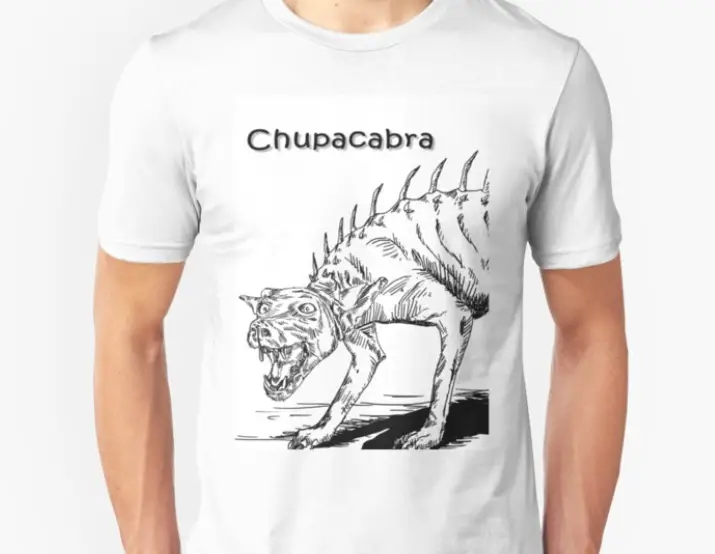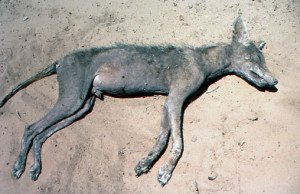Podcast: Play in new window | Download
Subscribe: Apple Podcasts | RSS
 Get the official t-shirt for this show here: https://teespring.com/chupacabra?tsmac=store&tsmic=mexico-unexplained&pid=2&cid=576
Get the official t-shirt for this show here: https://teespring.com/chupacabra?tsmac=store&tsmic=mexico-unexplained&pid=2&cid=576
The word Chupacabra comes from two Spanish words, chupa “suck” and cabra “goat.” Unlike many myths and legends that stretch back to times before people can recall dates, we know when the Chupacabra first appeared: March of 1995. Yes, that means it is a newly hatched cryptid, the new kid on the block of demons and monsters. Where did it come from? What does it look like?
We’ll answer the second question first. There are two types of creatures that have been sighted by people that have been classified as chupacabra. The first is one that looks like a reptile with spikes on its back, standing about 4 feet tall, often times with red eyes and wings like a flying squirrel. The second group of creatures look like a skinny, larger, hunched over dog with patchy fur or no fur. To the left is an artist’s rendition of the animal and below is a photo of what is supposedly a captured and killed chupacabra.
The chupacabra is a relatively new monster. It first appeared not in Mexico but in Puerto Rico. In the spring of 1995 the residents of 2 small Puerto Rican towns had discovered dead farm animals on their properties, and the animals had two incisions on their necks, and reportedly, all the blood drained from them. The creature was not spotted until 5 months later and the description was very vivid. The first encounter with the creature was described in detail at the time by the Puerto Rican tabloids and later in a book published in 1997 by Scott Corrales called Chupacabras and Other Mysteries. There are a great deal of books uut there on the chupacabra for children, like it’s the newest monster under the bed. There is not a whole lot of scholarly research done on this topic.

A flurry of sightings happened right after the creature was talked about on the pan-Latin American talk show hosted by the bleached blonde Cuban-born Cristina Saralegui called “Cristina”. The first sighting in Mexico happened right after that broadcast. Did the show give people permission to talk about this phenomenon or were people just hallucinating?
A wave of reports occurred in the late 1990s across northern Mexico and the state of Jalisco in central/western Mexico. Many of these sightings were of the wingless, hairless doglike creature. In May of 1996 there was a rash of sightings in the rural parts of the state and many dead animals with the characteristic bite marks on the necks, especially in goats and sheep. The director of the Guadalajara Zoo went out to some of the ranches and took plaster casts of footprints and said that the creature was probably a large dog. Two investigators from Mexico City Patricia and Mario Mendez Acosta also traveled out to rural Jalisco to look into the phenomenon. They even set up traps to catch the chupacabra and each time caught wild dogs. A local police official made a comment at the time saying that locally the chupacabra phenomenon could be explained away by wild dogs and that the wave of sightings was part of “una gran psicosis,” a great psychosis. Ironically, throughout Mexico, sightings of the chupacabra have been going down with time. Sightings are now few and far between.
 The early sightings in Puerto Rico, of the slightly winged reptile kind were blamed on UFOS and even the US military. America has long used PR as kind of a dumping ground, according to locals, and some people suspected that the chupacabra was some sort of chimera, the product of a biological experiment gone bad. There is also a story from a PR tabloid about how the creature was being transferred by the US military from a crashed saucer site and got loose after a wreck on a back road.
The early sightings in Puerto Rico, of the slightly winged reptile kind were blamed on UFOS and even the US military. America has long used PR as kind of a dumping ground, according to locals, and some people suspected that the chupacabra was some sort of chimera, the product of a biological experiment gone bad. There is also a story from a PR tabloid about how the creature was being transferred by the US military from a crashed saucer site and got loose after a wreck on a back road.
Some Mexican and Texan chupacabras have actually been tested and examined. The photo here is of a chupacabra supposedly killed in south Texas near the Mexican border. Animal experts have claimed that these are dogs, coyotes or even racoons with types of mange or scabies, diseases that stress the animals and cause their hair to fall out, make them look disheveled and give them a foul odor. The diseases may also weaken the animals to cause them to go after domestic livestock instead of hunting or foraging normally. There have been formal DNA tests on some of these animals to determine that they are indeed dogs or other known animals.
But what would explain those other sightings? The ones where the creature is standing upright or that it has spikes on its back or even wings? Is it part of a Gran Psicosis or an entirely new creature either recently discovered, manufactured in a lab or imported from another world?
REFERENCES
Radford, Benjamin. Tracking the Chupacabra. Albuquerque: University of New Mexico Press, 2011. Buy the book on Amazon here: https://amzn.to/2OxJsQU
Corrales, Scott. Chupacabras and Other Mysteries. New York: Greenleaf Publications, 1997. Buy the book on Amazon here: https://amzn.to/2OzfhZz
“Chupacabra Rides Again” Fortean Times, no. 156 (2002)
“Night of the Chupacabras.” Inexplicata: The Journal of Hispanic UFOlogy (blog post published June 1, 2010)

2 thoughts on “The Chupacabra”
My son Jesse and I enjoyed the podcast.
Jesse says, “If I was a chupacabra, I would drink the goat’s blood AND the milk, and FEAST on the meat too. Because goats are delicious.”
Great podcast!